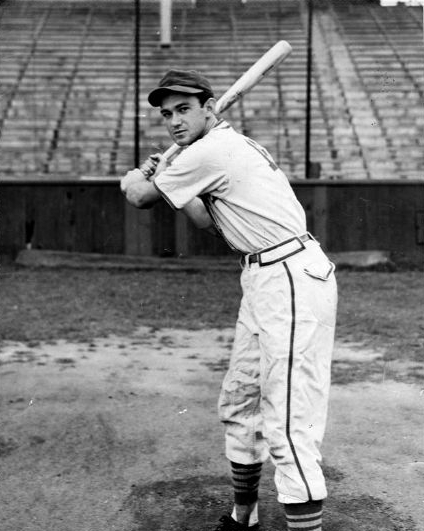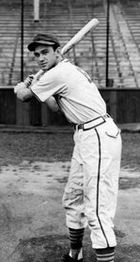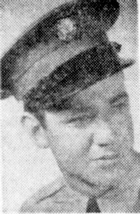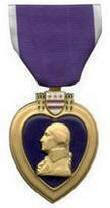Jim Whitfield
| Date and Place of Birth: | March 21, 1920 Graham, NC |
| Date and Place of Death: | September 22, 1944 Angaur, Palau Islands, Pacific |
| Baseball Experience: | Minor League |
| Position: | Outfield |
| Rank: | Staff Sergeant |
| Military Unit: | 322nd Regimental Combat Team, 81st Infantry Division US Army |
| Area Served: | Pacific Theater of Operations |
An outstanding ballplayer with a great career ahead of him, Jim Whitfield told his parents "don't worry about me," as he headed into combat.
James J. Whitfield grew up in Graham, North Carolina, with five
adoring sisters. He played the outfield for the Graham High School team,
where he earned a reputation as a superb defensive outfielder with an
outstanding throwing arm. "Jimmy Whitfield, playing in centerfield,
roamed far and wide to accept an even half dozen put-outs," reported the
Burlington Times-News in April 1938, "turning several seemingly sure
hits into outs, and as a climax to his brilliant fly chasing he made a
beautiful throw to the plate to put down a certain score in the sixth
frame." [1]
After graduating from high school, Whitfield played for the Travora Mill
team in the Tri-City League. Occasionally turning his powerful arm to
pitching, he threw a 32-0 four-hit shutout against Hopedale, on July 4,
1938, in which he also collected six hits, three of which were home runs
that cleared the left field fence. Later in the month, he struck out 14
and had four hits in a game against Belmont, and on August 25, he
pitched an 11-0 one-hitter against West Burlington. In 1939, Whitfield
was playing for the May Hosiery Mill team and in a late-August contest
against McEwen his "smoking bat accounted for four clean slugs in five
tries at the platter."
Whitfield went on to
play for the Cameos, the semi-pro team of the May-McEwen Kaiser textile
mill, where he played alongside future major leaguer Howie Moss. By May
1941, he was batting over .650 with the Cameos and had already hit
six home runs when he accepted a $5,000 bonus to sign with the St. Louis
Cardinals (Moss also left the Cameos at the same time, being reinstated
to the eligible list after being out of professional baseball for four
years). Whitfield bought himself a Plymouth convertible with the bonus
but also gave $100 to the Graham United Methodist church.
For the 1941 season, the 21-year-old was assigned to the Albany
Cardinals of the Class D Georgia-Florida League, where he got off to a
flying start. After a month he was batting .327, but an infected spike
wound resulted in blood poisoning and he was briefly hospitalized.
Returning to the team but still troubled by the injury, Whitfield
finished the season appearing in just 26 games for a disappointing .238
batting average. That was to be his only taste of professional baseball.
In November 1941, Whitfield entered military service with the Army and
took basic training at Camp Croft, South Carolina. Still at Camp Croft
in March 1942, he was promoted from private to corporal while with B
Company of the 34th Training Battalion.
In June 1944, Whitfield was stationed at Camp Beale, California, was
awarded the Expert Infantryman Badge, and had attained the rank of staff
sergeant. That month, attached to the 322nd Regimental Combat Team (RCT) of the 81st
"Wildcat" Infantry Division, he left for the Pacific. After being stationed at Hawaii for two months, the division's
first taste of combat was at Angaur, part of the Palau Islands. It was
essential to eliminate the enemy presence on the island group as a
threat to Allied lines of communication across the western Pacific
toward the Philippines. Moreover, Angaur could provide the Allies with
an air base in the forward area. Shortly before the invasion took place,
Whitfield wrote his parents. "Soon you will hear about our victory,"
stated the letter, which appeared in the Burlington Daily Times-News in
October 1944. "You will be shocked to know where we are. I want you to
know, in case something should happen, it was God's will ... we are the
best soldiers in the world. We have the best equipment and everything is
in our favor. For three years I have worked very hard for this chance. I
have two strikes on them and am about to throw a curveball. They can't
hit curve balls." [2]
On September 17,1944, Whitfield landed with the 322nd RCT at Red Beach
on the northeast shore of Angaur. Japanese forces had not defended the
beach but as U.S. troops moved precariously inland they were faced with
intense resistance. By September 20, most of Angaur was secure and it
was the job of 322nd RCT to mop up the remaining Japanese forces in the
northwest corner of the island. Cornered and led by the fanatical Major
Ushio Goto, the remaining defenders were prepared to fight to the death
rather than surrender. On September 22, 1944, during an enemy mortar
attack, Whitfield was killed. He was buried at Manila American Cemetery
in the Philippines.
Following his death, a baseball field was named in his honor by his
comrades; its exact location has been lost with time but it may have
been at New Caledonia where the 81st Infantry Division went for
rehabilitation at the beginning of 1945.
|
Year |
Team |
League |
Class |
G |
AB |
R |
H |
2B |
3B |
HR |
RBI |
AVG |
| 1941 | Albany | Georgia-Florida | D | 26 | 105 | 10 | 25 | 7 | 1 | 2 | 14 | .238 |

Notes
1. Burlington Times-News, April 1, 1938
2. Burlington Daily Times-News, October 20, 1944
Thanks to Jay Ashley, managing editor of the Burlington Times-News, for help with this biography. Thanks also to Astrid van Erp for help with photos and information for this biography.
Date Added May 22, 2012 Updated August 3, 2017
Baseball's Greatest Sacrifice is associated with Baseball Almanac
Baseball's Greatest Sacrifice is proud to be sponsored by



